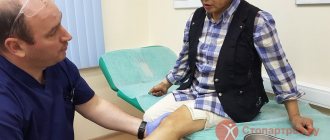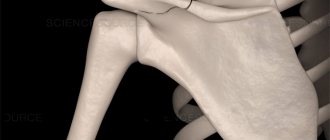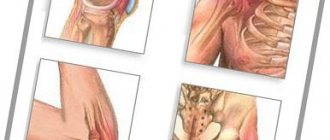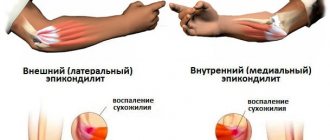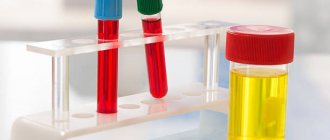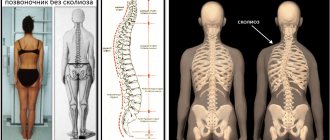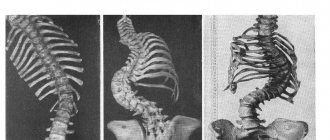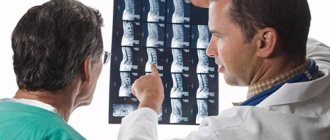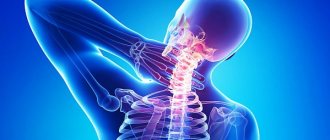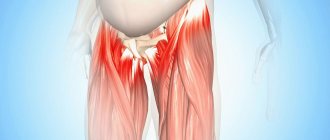The neck is an important “component” of the human body, which consists not only of the spine, but also of ligaments, nerves and large arteries. However, a crunch in the neck when turning the head or a slight crunch in the neck during physical activity can occur in people who do not have health problems.
The cause of the crunch may be a disease such as cervical osteochondrosis. In this case, the intervertebral discs lose their natural elasticity while simultaneously deforming the vertebrae. In the article we will answer the question, what are the causes of a crunch in the neck and how to get rid of this ailment.
Why does noise in the head appear with cervical osteochondrosis?
Osteochondrosis of the cervical spine is a disease of the whole body, since its symptoms are not limited only to the neck. Physical well-being deteriorates, endurance, performance and concentration decrease. Patients complain of headaches, which can be migraine-type, dizziness, surges in blood pressure, blurred vision, forgetfulness, and buzzing in the head.
This “bouquet” of symptoms is associated with the pathogenesis and mechanism of development of cervical osteochondrosis, which is a degenerative disease. Due to damage and destruction of the cartilage tissue of the vertebral structures, pinching of the vertebral artery occurs, mechanical pressure on the sympathetic nerve. This provokes the occurrence of noise in the ears and head with osteochondrosis.
Kazieva Aminat Ziyavovna
Neurologist
Rostov State Medical University
Experience since 2012
The intensity of symptoms depends on the stage of the disease, as well as on the degree of compression of blood vessels and nerve endings:
- Stage I. Pain in the neck is barely noticeable; pain occurs only when turning the head sharply or wearing a backpack. Stiffness appears in the morning or after sitting in one position for a long time.
- Stage II. In addition to pain in the neck, headaches, chronic fatigue appear, cognitive abilities deteriorate, there are vision problems, and performance decreases.
- Stage III. This stage is characterized by severe wear of the intervertebral discs, which causes protrusions, bone growths (osteophytes), and hernias. The symptoms are severe. A crunch appears in the neck, and contractures may occur. The patient has a severe headache, frequent dizziness, ringing in the ears, and darkening of the eyes. Pain can radiate to the occipital region and upper extremities.
- Stage IV. Due to severe destruction of cartilage tissue, the functions of the spine are disrupted. As a result, blood vessels and nerves are pinched. Against the background of constant trauma to the nerve roots and blood arteries, neurological symptoms and signs of the vascular type only intensify. Contractures occur, due to which a person cannot turn his head
The main cause of noise in the head and ringing in the ears is a violation of the blood supply to the brain and inner ear. The patient's condition may worsen due to hypothermia of the cervical spine, endocrine and hormonal disorders, after infectious diseases, otitis, due to the abuse of strong tea or coffee, and a sedentary lifestyle.
To prevent complications, it is important to recognize the first signs of pathology in time and seek the help of specialists.
Medication methods for eliminating crunching
Crunching in arthrosis, arthritis, osteochondrosis disappears during treatment of the underlying pathology. To eliminate it, you can use non-steroidal anti-inflammatory painkillers in the form of ointments, creams, and gels. These include Ortofen, Nurofen, Nise, Fastum, Artrosilene, Indomethacin, Ketonal, Diclofenac.
The drugs have powerful anti-inflammatory, anti-exudative, and analgesic effects. After their course of use, the functional activity of the cervical vertebrae and intervertebral discs increases by reducing the severity of soft tissue edema.
The crunching caused by muscle spasms can be eliminated by taking muscle relaxants (Mydocalm, Baclofen, Sirdalud), which relax the skeletal muscles.
The active ingredients of systemic chondroprotectors are chondroitin and glucosamine, which can partially restore cartilage tissue, ligaments, and tendons. Doctors recommend long-term (from several months to 2 years) course of taking these drugs for patients with pathological and natural crunching in the cervical vertebrae. What a rheumatologist or vertebrologist can prescribe:
- tablets, capsules, dragees - Teraflex, Structum, Chondroxide;
- injection solutions - Alflutop, Dona, Rumalon, Chondroitin-Akos;
- ointments, creams, gels - Chondroxide, Teraflex, Arthro-Active from the blue line.
The cause of the crunch may be insufficient supply of nutrients to the cartilaginous vertebral structures. To increase the production of synovial fluid, doctors prescribe injections of hyaluronic acid (Synvisc, Ostenil).
Crackling and clicking sounds that accompany any movement of the head can be eliminated using external agents with a warming effect (Capsicam, Finalgon, Apizartron, Viprosal, Nayatox). Their main therapeutic effects are improving blood circulation in the cervical region and stimulating the regeneration of damaged tissues.
How to determine that noise in the head is from osteochondrosis:
You cannot engage in self-diagnosis and self-medication, since noise in the head against the background of osteochondrosis can be confused with another disease: hypertension, cerebral aneurysm, auditory neuritis, atherosclerosis, brain tumor.
Let's look at the specific signs of the disease.
Neck pain and headache
One of the first manifestations of cervical osteochondrosis is pain in the neck, back of the head, and collar area. Its nature and intensity depend on the stage of the pathology.
At the initial stages, it is mild, periodic, similar to muscle strain, and can spread from the neck to the entire head. The pain is aching, intensifies after sleep, prolonged stay in one position. It can go away on its own after warming up the neck, without taking painkillers.
Kazieva Aminat Ziyavovna
Neurologist
Rostov State Medical University
Experience since 2012
In the later stages, the pain becomes constant, it is so strong that the person cannot move his head. Without treatment, “lumbago” occurs - attacks of sharp pain that immobilize.
The noise in the head increases as blood circulation worsens. At first it appears only under the influence of irritants:
- sudden movements;
- stress;
- temperature changes;
- physical and emotional fatigue;
- staying in one position for a long time, working at the computer.
Without treatment, it bothers a person even at rest, which disrupts psycho-emotional balance and can cause nervous breakdown and depression.
Pain in the back of the head
Pain in the neck gradually moves to the occipital region, and then to the temples. It is associated with the destruction of cervical vertebral discs and pinched nerve endings. But it is always accompanied by other neurological symptoms. The most common include noise in the head and headache.
Noise in the head when turning the head
With osteochondrosis, any change in head position provokes noise or ringing. As the intervertebral discs become deformed, the functions of the spine are impaired. It is difficult for a person to turn his head and move the upper shoulder girdle. Such movements are accompanied by pain, crunching, numbness and other neurological signs.
Headaches and head pressure
Cervical osteochondrosis is almost always accompanied by headaches of various localizations, depending on the damaged spinal segment. It is often accompanied by dizziness, noise in the head, blurred vision and impaired coordination of movements.
Characteristics of headache:
- has a “cervical” character, that is, it appears when moving the neck, being in one position;
- Tension headaches can occur in the morning due to the head remaining in one position for a long time or at the end of the working day;
- localized in the area of the back of the head and crown, in the temples, less often in the frontal part, in the area of the orbit;
- can spread to the entire head or cover only half;
- often has a sharp, pulsating or vascular character, that is, there is one painful pulsating point;
- not relieved by analgesics for headaches.
Often the pain syndrome has the character of pressure on the skull and eyeballs. Sometimes there is not a throbbing or squeezing pain, but a strong bursting pain.
If the pain syndrome is of the migraine type, then the pain sensations going from the back of the head to the temples intensify when changing position, nausea, vomiting occurs, and darkening in the eyes. In severe cases, the condition is close to fainting.
Congestion in the ears and noise in the head
When the pain in the neck intensifies, that is, osteochondrosis progresses, noise in the head appears, a feeling of stuffy ears, ringing in the ears. These signs are most pronounced when there is a sudden change in body position or when sudden movements are made. Often accompanied by dizziness.
Congestion and ringing in the ears may indicate high blood pressure, which is a consequence of cervical osteochondrosis. Hypertension occurs due to compression of blood vessels, its symptoms:
- ear ringing;
- congestion in one or both ears;
- headache, dizziness;
- chest tightness that leads to difficulty breathing;
- nausea;
- increased sweating;
- feeling of heat in the face.
Pressure surges often occur against the background of physical or psycho-emotional stress, after overheating in the sun, or sudden movements. They can cause a hypertensive crisis, stroke or heart attack, so ringing and other sounds in the ears and head cannot be ignored.
Diagnosis of pathologies
If the neck makes a crunching sound and hurts with every movement, this is not enough to make a final diagnosis. Such a complex symptom requires detailed study, so the doctor must prescribe the following types of medical diagnostic examinations:
- X-ray examination
: allows you to obtain comprehensive information about the condition of bone structures. - Electromyography: necessary to determine the condition of the muscles and nerves responsible for their functioning.
- MRI
: best shows the condition of soft tissues. - Echoencephalography: an effective method for studying brain tissue.
- ECG
: gives general information about the state of the cardiovascular system, which may be the cause of pain and crunching.
It is worth remembering that when your neck hurts, the crunch cannot be deciphered independently as a symptom of a certain disease. Even a qualified doctor will not do this without modern medical examinations.
Which doctor should I contact for noise in the head due to osteochondrosis?
A neurologist treats osteochondrosis, its symptoms and consequences.
Since the disease has dangerous complications, you should choose an experienced specialist who can develop an individual and effective treatment program. Neurologists from the medical center in Rostov-on-Don have extensive experience in treating neurological diseases.
To make an appointment, you can call or leave a request on the website. A call center operator will contact you within 10-15 minutes.
How is cervical osteochondrosis diagnosed?
Diagnosis begins with studying the patient's complaints. The doctor conducts a survey, determines for himself the key points: localization, intensity, duration, type, nature, conditions for the occurrence of noise. Then he begins a physical examination, palpating the cervical spine, and measuring blood pressure.
Kazieva Aminat Ziyavovna
Neurologist
Rostov State Medical University
Experience since 2012
After the initial examination, a full instrumental examination is required, which includes:
- radiography;
- computed tomography (CT) of the ear, spine;
- magnetic resonance imaging (MRI) of the head;
- audiological examination, including tympanometry, reflectometry;
- duplex scanning or Doppler ultrasound of the vessels of the head and neck.
MRI is the most informative for neck pain and noise in the head, so this type of examination is advisable for everyone who has been diagnosed with cervical osteochondrosis.
The medical department has a Siemens Symphony 1.5 Tesla tomograph, which provides high information content and allows you to identify the slightest changes. Immediately after the examination, the diagnostician announces the results and explains how serious the detected pathology is.
To assess the nature and extent of the pathological process, examination of the thoracic and lumbar spine may be necessary, especially if there is pain in the lower back or chest.
Sometimes, in addition to a neurologist, consultation with an ophthalmologist, otolaryngologist, endocrinologist, orthopedic traumatologist, cardiologist, and neurosurgeon is required.
How to relieve an attack?
With vasospasm and significant circulatory impairment, severe pain occurs, noise and pulsation in the head interfere with work. You can alleviate the condition using the following methods:
- taking painkillers and antispasmodics - helps reduce pain;
- the use of local and systemic anti-inflammatory non-steroidal drugs - reduce pain, can remove pinched nerve endings, relieving inflammation;
- massage – helps relieve neck muscle spasms and eliminate tension.
With these measures you can get rid of the symptoms of cervical osteochondrosis, but only temporarily. The disease must be treated, and complex therapy is required.
ethnoscience
It is hardly possible to cure a neck crunch at home if there is a serious problem, but sometimes folk recipes will not be out of place in combination with highly effective drugs. For this purpose, compresses, rubbing, infusions, and decoctions based on medicinal herbs are used.
It is possible to prepare an infusion of celery root at home. To do this, pour boiling water over a tablespoon of raw material and leave overnight in a thermos. Then drink 50 grams three times a day.
To relieve pain, you need to infuse black radish in vodka with the addition of honey, proportions 3:2:1. Apply rubbing at night.
The use of hirudotherapy has a positive effect. It is better to carry out this treatment in a specialized clinic under the supervision of a doctor. Treatment with leeches reduces radicular syndrome, reduces headaches, and improves immunity.
Treatment of noise in the head with cervical osteochondrosis
Without eliminating the underlying disease, it is impossible to get rid of noise in the head. But osteochondrosis is a chronic progressive pathology that is problematic to cure, especially if the pathological process has been going on for several years and is in an advanced stage.
Note! Only the initial stages of cervical osteochondrosis are treated. In other cases, treatment is aimed at inhibiting degenerative processes.
To reduce the manifestations of osteochondrosis, complex therapy is required, which includes:
- use of medications;
- physiotherapeutic procedures;
- massage;
- therapeutic exercises;
- wearing orthopedic devices (Schants collar).
In case of displacement of the vertebrae, formation of osteophytes, hernias, or severe narrowing of the lumen of the spinal column, surgery is performed. All defects that cannot be removed conservatively are removed surgically.
Drug therapy
To treat noise in the head, the following groups of drugs are used:
- analgesics;
- muscle relaxants;
- non-steroidal anti-inflammatory drugs;
- corticosteroids;
- chondroprotectors;
- vitamin and mineral complexes;
- sedatives;
- diuretics, decongestants;
- medications to improve cerebral circulation (some of them are contraindicated for low blood pressure);
- antihypertensive drugs;
- nootropics.
The course of drug treatment for noise in the head with cervical osteochondrosis can last several months, depending on the severity of the patient. Throughout the entire therapy, the neurologist monitors the patient’s condition and adjusts the treatment regimen.
Physiotherapeutic procedures
To reduce muscle spasm and tension, the following procedures are used:
- magnetic therapy;
- laser therapy;
- UHF;
- electrical stimulation;
- phonophoresis;
- electrophoresis;
- mud therapy.
To reduce noise in the head, manual techniques, acupuncture, and underwater traction are used.
Kazieva Aminat Ziyavovna
Neurologist
Rostov State Medical University
Experience since 2012
Note! All physiotherapeutic procedures are carried out strictly according to indications, according to the schedule.
Massage
It is an obligatory part of the treatment of headaches and noise in the head due to osteochondrosis, but there are contraindications to massage:
- severe pain syndrome;
- severe compression of the nerve roots;
- hypertonicity of the muscles of the cervical-collar area;
- acute inflammatory process;
- hypertension;
- thrombosis;
- aneurysm;
- oncological diseases.
Massage relaxes muscles, improves blood circulation and reduces neurological symptoms. It is performed by a physical therapist or chiropractor. Treatment must be combined with neck exercises.
Note! Some therapeutic massage techniques are available only to qualified specialists, so they cannot be repeated at home.
Physiotherapy
The first training sessions should take place with an instructor, since exercises are selected individually for each patient. They help strengthen muscles, eliminate tension and normalize blood circulation.
Gymnastics is also a mandatory preventive measure for the occurrence of symptoms of cervical osteochondrosis. A set of exercises should be performed daily, 3-4 times a day. When working at a computer, warm-up is required every 1.5-2 hours.
Note! For osteochondrosis in the cervical spine, swimming and water aerobics are useful. Water relieves the spine, and physical activity helps strengthen the muscle frame.
Prevention
If after treatment your neck does not hurt and the crunching has stopped, you should eliminate from your life what caused the unpleasant symptoms. This is what prevention is all about:
- A balanced diet: a sufficient amount of vitamins, microelements and fluids will allow you to maintain bones and cartilage in working condition.
- Physical exercise: especially recommended for those who have to spend a lot of time at the computer.
- Maintaining a healthy weight: Obesity puts serious stress on the spine and worsens its condition.
- Reasonable load on the spine: evenly distribute the load on your arms when carrying bags, avoid lifting heavy objects.
- Rejection of bad habits.
And, of course, it is categorically not recommended to intentionally crack your neck, since in this case there is a possibility of damaging the joint.

